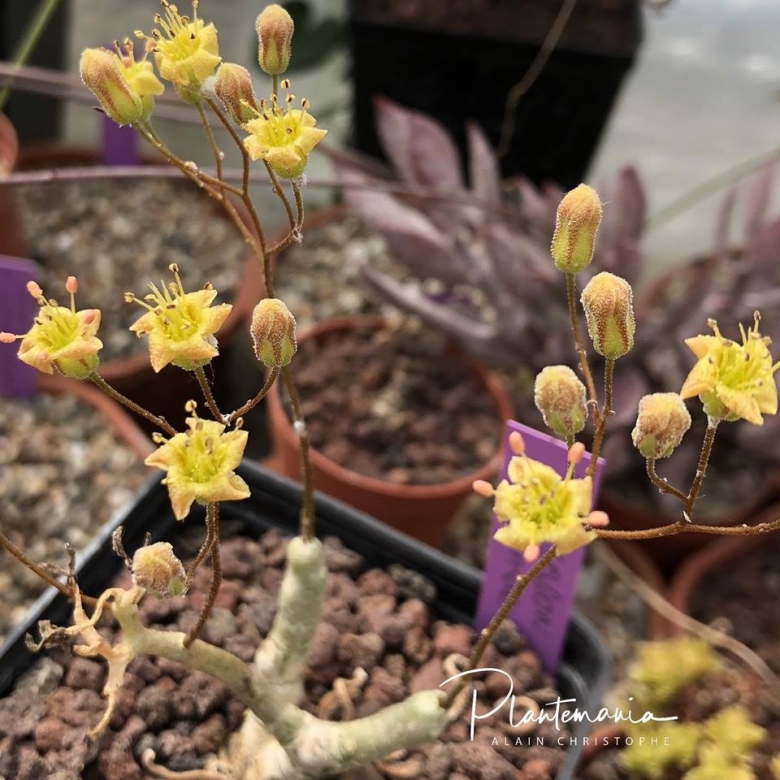




Your support is critical to our success.
Accepted Scientific Name: Tylecodon pygmaeus (W.F.Barker) Toelken
Bothalia 12: 380 1978.

Origin and Habitat: Western Cape (Knersvlakte from Koekenaap to north-east of Bitterfontein), South Africa. Tylecodon pygmaeusSN|35311]]SN|35311]] is a range-restricted species (Extent of occurrence 534 km²), but locally common species.
Type Locality: Cape, near Vanrhynsdorp.
Habitat and Ecology: Succulent Karoo. Tylecodon pygmaeusSN|35311]]SN|35311]] is is a common pioneer species that grows on quartz gravel patches on flats and gentle slopes. It is summer-flowering. There has been some mining applications on parts of this species' range (N.A. Helme pers. comm.), and if mining proceeds, some subpopulations may be lost. The species is difficult to cultivate as it does not grow well outside its native habitat (Van Jaarsveld and Koutnik 2004), and may possibly be targeted by succulent collectors. It is however very common, and collecting is not considered to be causing population decline at present.
Synonyms:
- Tylecodon pygmaeus (W.F.Barker) Toelken
- Cotyledon pygmaea W.F.Barker
AFRIKAANS (Afrikaans): Dwerg Botterboom
Description: Tylecodon pygmaeusSN|35311]]SN|35311]] is a small perennials with short, often branched tubers (caudex) producing one, rarely few smooth erect branches 10 - 20 cm long with grey bark often with dark grey striations, with a subterranean tuberous base.
Tuber: Up to 7 cm in diameter, hard, with pinkish-brown flesh, covered with thin layers of brown bark.
Stem: The single (rarely more) stem branch is robust, 5-10 mm thick and from 50-200 mm in height, the younger stems are smooth, grey, 8 mm in diameter at the base tapering to 3 mm, and without phyllopodia.
Leaves: Linear-oblanceolate to almost terete and club-shaped, (2-)5-25(50) long, (3-)4-9(-45) mm thick, base cuneate, usually obtuse-ended, green, densely covered with shiny, crystal-like, cordate (heart-shaped) hairs.
Inflorescences (thyrses): The peduncle is (15-)30-50 mm long, purplish-brown, with 1-3 (-5) monochasia, each with inconspicuous 1-3 erect flowers, glandular-pubescent. Pedicels 5-15 mm long.
Flowers: Calyx 2-3,5 mm long, covered with heart-shaped trichomes, green; lobes (sepals) triangular-lanceolate, bluntly acute. Corolla, pale yellowish green often tinged pink, nearly glabrous or with few elongate trichomes outside; tube cylindrical to urn-shaped, short, only 4-6 mm long, usually glabrous inside; lobes as long as the tube, spreading becoming recurved, 4-5,5 mm long, pale yellowish green to yellow. Anthers 1,2-1,5 mm long. The nectaries are almost square, with abaxial median groove, brilliant red. Squamae transversely oblong to oblong, 0,8-1,1 x 0,5-1,2 mm, usually slightly emarginate, fleshy, yellow.
Taxonomy note: Tolken's var. tenuis for the weaker-stemmed plants in the same locality has been elevated to species level (Bruyns in S. Afr. J. Bot. 58(1), 1992).
Bibliography: Major references and further lectures
1) Urs Eggli “Illustrated Handbook of Succulent Plants: Crassulaceae” Springer Science & Business Media, 06 December 2012
2) J.P. Roux, “Flora of Southern Africa”, 2003
3) Doreen Court “Succulent Flora of Southern Africa” CRC Press, 01 June 2000
4) Raimondo, D., von Staden, L., Foden, W., Victor, J.E., Helme, N.A., Turner, R.C., Kamundi, D.A. and Manyama, P.A. 2009. “Red List of South African Plants”. Strelitzia 25. South African National Biodiversity Institute, Pretoria.
5) Tölken, H.R. 1978. “New taxa and new combinations in Cotyledon and allied genera. Bothalia” 12(3):377-393.
6) Tölken, H.R. 1985. Crassulaceae. In: O.A. Leistner (ed). “Flora of southern Africa” 14,1:1-244. Botanical Research Institute, Pretoria.
7) Van Jaarsveld, E.J. and Koutnik, D. 2004. “Cotyledon and Tylecodon”. Umdaus Press, Pretoria.
8) Helme, N.A., le Roux, A., von Staden, L. & Mogale, M.M.P. 2015. Tylecodon pygmaeus (W.F.Barker) Toelken. National Assessment: Red List of South African Plants version 2017.1. Accessed on 2018/08/12
| Your Actions | |
|---|---|
| Back to Cotyledon index | |
| Back to Crassulaceae index | |
 |
Back to Succulents Encyclopedia index |
Privacy stantement - Terms and conditions - How to cite - About us - Feedback - Donate



